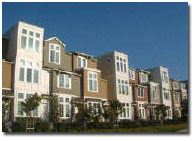|
A Modular Home can look just like a custom stick-built structure and nobody would know the difference. A modular home is delivered to site 90% completed and assembled within weeks, saving time, money, and aggravation. Modular homes being built today have all the residential appeal of a custom stick-built home but costs 10% to 30% less. Modular homes qualify for conventional financing and appreciate at the same rate as stick-built homes.
 If you are a builder or developer who is tired of the intense dynamics of stick-built construction, you will find the reduced demands of installing modular homes an attractive way to stay in the homebuilding industry while reducing your stress. If you are a builder or developer who is tired of the intense dynamics of stick-built construction, you will find the reduced demands of installing modular homes an attractive way to stay in the homebuilding industry while reducing your stress.
Frustrations with sub-contractors, bad weather, scheduling delays, supplier problems and lack of quality labor in general are just some of the reasons why many builders, developers and investors have turned to modular construction.
Modular construction offers numerous advantages over traditional or "conventional" building methods.
There is no other method available today that allows you to start and finish a building project in a more-timely manner than modular construction. The factory can be constructing the home and site preparation work can proceed simultaneously, allowing projects to be completed in a much shorter time-span, without sacrificing safety or quality.
- Affordability - Since the houses are built in a factory by a stable work force under controlled conditions with more predictable raw material inventory and supply, assembly is much more efficient, resulting in structures less expensive than stick-built housing by at least 10% to 30%.
- Sound Construction - Modular construction is tighter and stronger compared to stick-built or traditional methods. On average a modular home will use 20% more lumber, producing a more energy efficient home. Modular homes are over engineered in order to withstand the transportation to job site.
- The controlled indoor environment and experienced labor force can construct with consistent quality. Workers familiar with their product can easily integrate materials and techniques into the process when working side-by-side with individuals of other trade backgrounds.
- Quicker Schedule - Modular homes are assembled in a factory while earthwork, foundations, and utilities are prepared on-site. When properly scheduled, the modular sections or modulars can be installed on-site within a week or two of delivery. Also, the quick building cycle of modular construction can reduce or eliminate job site vandalism and theft. Complete hook-up, final grading, and landscaping can usually be completed within one month, often sooner.
- Reduced Waste - Waste materials are minimized, and the waste generated is much more easily reused and recycled in a factory environment. Everybody is talking, “GREEN” today and many modular home facilities around the country are starting to utilize recyclable materials into their homes.
- Less Site Impact - Since the site schedule is compressed, far fewer materials are stored on-site, fewer workers are on-site for less time and make less noise, and there is generally no need to have large dumpsters sitting around for extended periods--if at all. This all makes for happier neighbors.
 The scale and repetition that characterize many multifamily buildings lends itself to modular construction techniques. Modular multiple dwellings can usually be delivered and installed for less than $60 to $70 sq. foot, especially if a factory is located near the job site. Stacking modulars on top of each other is very cost effective and helps reduce noise levels for tenets because of the additional space between floor joists and marriage walls. The scale and repetition that characterize many multifamily buildings lends itself to modular construction techniques. Modular multiple dwellings can usually be delivered and installed for less than $60 to $70 sq. foot, especially if a factory is located near the job site. Stacking modulars on top of each other is very cost effective and helps reduce noise levels for tenets because of the additional space between floor joists and marriage walls.
Modular construction does not lend itself to large clear spans of 20 feet but, this is not a problem for most designs. Light commercial projects such as townhomes, condos or apartments are a perfect fit for modular building. Typically, anything less than a three-story building can be modular. Three-story structures or higher are more complicated and usually require steel or concrete as the main support structure.
In addition, cranes must be used on-site to offload the sections and place them on the foundation. Cranes can be expensive; so this process must be carefully planned and coordinated.
If you’re considering modular construction we would like to talk with you. Best selling author and factory-built housing consultant Randall Eaton has helped hundreds of builders, developers and investors from around the country. To learn more about the advantages of modular construction please fill out the form below. Once we receive your information Randall will contact you to discuss your building project in more detail. This is a FREE consultation and our goal is to help you find quality manufacturers or builders that can assist you with your project.
|